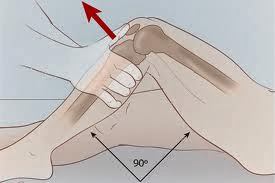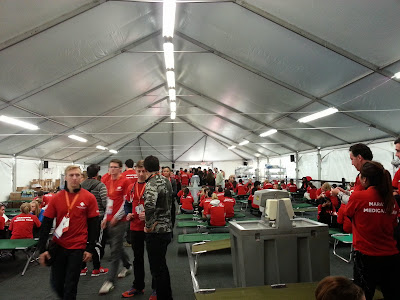Running with frozen toes!
 In honor of the lovely coating of white wonderland that New York has gotten this morning, and in honor of my first snow run since early November when we had beautiful snowflakes that didn't stick, I thought it's about time for a blog on outdoor training during the winter months. So read on for tips on how to keep training outdoors and fighting your SAD with some fresh air and exercise despite the elements :)
In honor of the lovely coating of white wonderland that New York has gotten this morning, and in honor of my first snow run since early November when we had beautiful snowflakes that didn't stick, I thought it's about time for a blog on outdoor training during the winter months. So read on for tips on how to keep training outdoors and fighting your SAD with some fresh air and exercise despite the elements :)
LAYER, Layer, Layer, layer, layer...LAYER!
The best thing to do to stay warm while being active in the winter months is to layer your clothing and choose wisely. Everyone is different in the amount of clothing they prefer. Keep in mind that you are going to warm up., but also keep in mind that the longer your workout, the more sweating you will do, and the more important it is to have fabrics that absorb moisture away from your body to keep you dry. By the end of a long endurance workout, you will get even colder, if you don't layer properly. This is really a lot of trial and error about what works for you, but some general guidelines are:
1. Your first layer should be tight-fitting tech-wear that absorbs moisture. Often, some folks will choose warmer weather compression clothing for this layer, or some use colder weather compression clothing for this layer.
2. A middle layer can be added that is a little more loose-fitting but still wicks away moisture (still tech wear).
3. One to two outer layers, depending on how warm you like being --
*A bulkier insulating layer
*And then the outer-most layer should be something loose that blocks wind. A very thin wind-breaker does a WORLD of difference for keeping you warm, since 80% of the heat loss your body experiences is due to wind. Just try it. You may find you don't need as many of the other layers if you have this. They make some nice fitted ones for cycling. This one is even water-proof: http://www.pearlizumi.com/publish/content/pi_2010/us/en/index/products/men/ride/apparel/6.-productCode-11131102.html
The best thing about layering? You can take things off if you get too hot! But don't go crazy with that, since you don't want to cool-down too quickly after your body has worked so hard to get all your muscles warm and firing in the cold weather.
ACCESSORIZE
Again, everyone is different in what they need. My husband and I have done a lot of trial and error on this stuff after training in a pretty intense New York winter during our prep for Ironman New Zealand. He wore crazy ski gloves when we did our endurance runs because his hands would always get so numb and cold, and I wore Under Armour Cold Gear shirts that I would pull over my hands because I couldn't stand wearing even the lightest gloves because my hands would get so hot after the first 30 minutes, and then I wouldn't want to have to hold onto them if I took them off. They make a lot of outer layers that are made to come over your hands, which are awesome for running. I prefer these to gloves, but everyone is different :)
So, from head to toe, here are some examples of good accessories to keep you warm and keep you getting your fresh air and preventing SAD with consistent training during those winter months:
Head protection:
 |
| Headed out for a 2-degrees-Farenheit-feels-like-minus-17 winter training run, and we are prepared! :-P |
Always a good idea for everyone, since your head is where you lose most of your heat. Again, something tech-wear is a good idea to absorb sweat. Some people like full hats or hoodies and some like head-band-type adornments.
Check out face masks – not just for robbing banks after all!
Your face can get a lot of exposure when you are bundling everything else up, and I have to say, I do have one of these!
Try feet and hand warmers like these
Little hotties :) http://www.amazon.com/
For your running toes
For your cycling toes
These are uh-mAAAAAAzing! These are the key to training for races when you know you have to get in an outdoor ride even in the winter time :) They really make a difference.
For your soles
Get some traction:
I haven't used these, so I'd be psyched to know how everyone feels about them.
BE SAFE
My husband is going to laugh if he reads this, since I am one of the least safe athletes out there, but, be smart about the days you choose to train. If the world is a solid sheet of ice, no one will judge you for running on the treadmill that day or watching a sports movie while you hop on your bike trainer. Gyms often have great deals this time of year for people wanting to get in shape during or after the holiday season, fitness classes will be in full swing, and winter is always a great time for the indoor pool! We all know that we enjoy outdoor workouts, but you don't have to put yourself at risk of injury. If you want to get out there even in the most dire climates, though, keep these remaining tips in mind...
WARM UP
Try warming up first inside before heading out for a run. Bike-runs aren’t just for triathletes anymore! Bike 10-15 minutes on an indoor bike and then start your run; you’ll be able to run faster right away and you’ll already have a little sweat and increased circulation to your extremities to keep you warm.
COOL DOWN (well, warm up again)
*Return to childhood--> drink hot coccoa!
Normally after a hot run, it’s no trick to find ways to replenish calories and fluids because an ice-cold smoothie or protein shake is just the ticket to cool you down. But, after your extremities are feeling cold and numb during a long winter run, it can be hard to come inside and properly re-hydrate. Welcome to my favorite winter recovery drink—hot chocolate! Chocolate milk has been a known great recovery drink to replenish carbs and protein after workouts, so why not try the winter version? It warms you up from the inside out, and you are drinking fluids without feeling even colder afterward.
*Take a hot shower. But not too hot.
A hot shower after a long cold run feels like such a nice present, but don’t go too hot on the water. Heat feels good after being cold for a long time, but hot and long showers can easily dry out the skin during a time of year where your skin is already fighting dryness. Especially if you have problems with eczema or dry skin, this is not the cure for you. Keep your shower down to a few minutes and make sure to lotion up afterward with a good emollient like Aquaphor or Eucerin while the skin is still moist to help hold in moisture.
I hope these tips keep you training outdoors this winter and feeling healthy even with all those tempting treats at holiday parties :) I enjoy a snow run because it always makes me feel like a little kid playing in the snow, so I hope to see a few of you little-kids-at-heart out there on the road/trail, but stay safe and stay warm :)
Until next time folks!



















